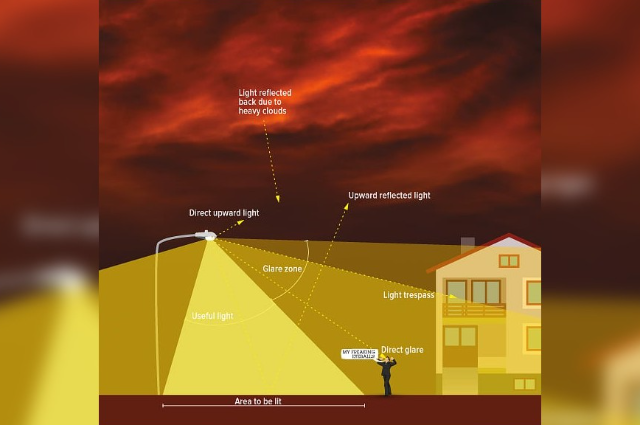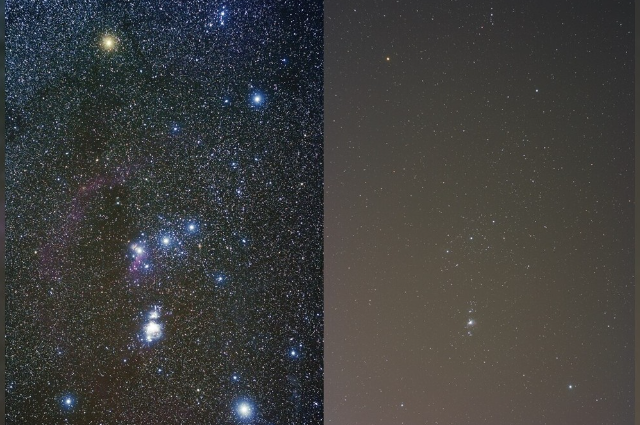The light bulb was invented over 140 years ago, and today more than 83% people in the world and 99% Americans and Europeans live under light-polluted skies. Light pollution is affecting the lives of humans, animals, and birds. Organisations are being set up across the globe to bring back dark skies and reduce light pollution. The world is now struggling with a new form of pollution- Light Pollution!
But What is Light Pollution?
Light pollution is the over-illumination of cities and night skies by artificial lighting. It is caused by an abundance of light sources emitting light outside of their intended directions. One of the direct effects of light pollution is that the skies appear less and less dark when viewed from the ground. This can lead to unintended yet harmful impacts on the ecosystem.
The following diagram depicts light pollution occurring from a street light.
Types of Light Pollution
Light pollution is divided into six categories based on its characteristics and impact on visibility and health:
- Light Trespass: From the word trespass, this type of light pollution occurs when excess and unwanted light spreads over areas where it is not needed, such as excess light from a street lamp entering a house. Light pollution of this kind occurs from the light emitted between 80° to 90° to the source (refer to the diagram above).
- Over Illumination: As the name suggests, this type of light pollution occurs when more light is provided than necessary. The three best examples to demonstrate this are:
a. Companies add additional lighting to their buildings to show their economic strength and to push working hours into the night
b. Shops add more lights to attract customers
c. People in some areas ask for daylight lighting to reduce crime - Glare: Glare occurs when excess light from the source enters the eyes and causes visual discomfort. One of the best examples is of vehicles having high-intensity headlights installed separately, which causes discomfort to the drivers of the incoming vehicles.
- Light Clutter: This kind of pollution occurs when different light sources are grouped. It can be street lights installed in the wrong direction or lots of billboards and advertisements set up to attract customers.
- Sky Glow: One of the worst types of light pollution is Sky Glow. While the other types mostly affect humans, Sky Glow is a threat to other organisms as well. Sky glow is the brightening of the night sky, mostly over urban areas, due to the electric lights of cars, streetlamps, offices, factories, outdoor advertising, and buildings, turning night into day for people who work and play long after sunset.
- Satellite Pollution: While this may not be a kind of light pollution right now, scientists argue that the increasing number of satellites, especially in the lower Earth orbits, can lead to light pollution as well. This is caused by the panels of the satellite reflecting light on Earth and also creating light streaks in the atmosphere.
Impact of Light Pollution
Some of the innumerable impacts of light pollution on the ecosystem are classified as follows:
- Ecological Impact:
- Birds migrating at night have evolved over the years by following the moonlight. However, with city lights outshining the night sky, the birds get confused and often lose track of their destinations.
- Sea turtles hatch their eggs on the shore, and the newborns tend to find their way to the seas by moving away from the dark surroundings, but given the excess light in today’s world, only a few can reach the seas while others die in the process.
- Large numbers of insects, a primary food source for birds and other animals, are drawn to artificial lights and are instantly killed upon contact with light sources.
- Excess light interferes with the sleep schedule of birds. Scientists have observed that blackbirds (Turdus Merula) in cities in Germany wake up as much as five hours earlier than those in rural areas.
- Astronomical Impact:
- Sky Glow has caused the stars to either shine faintly or get outshone by the city lights entirely.
- Astronomers are forced to set up telescopes in remote areas because light trespassing in cities interferes with the image of the celestial bodies formed on the lens.
The constellation Orion, imaged at left from dark skies, and at right from within the Provo/Orem, Utah metropolitan area
- Health Impact:
- One of the biggest issues of light pollution in the form of trespassing is interference with our sleep cycle. Most people in cities have unnecessary light falling into their homes and bedrooms, which makes it difficult to fall asleep due to reduced melatonin secretion.
- Working under excessive lights at night can lead to eye strain, fatigue, headaches, less focus, and much more.
- As mentioned earlier, glare from high-intensity light beams makes it difficult to drive at night, thereby increasing the risk of accidents.
- A lot of fuel is used to produce the excess light that we use in our daily lives, and this results in other forms of pollution, which again impact our health.
Steps Taken to Combat Light Pollution
While Light Pollution is a growing problem, governments and people acknowledging the issue have set up organisations to tackle it.
- DarkSky International (formerly International Dark-Sky Association) was the first organisation formed in 1988 to create dark sky reserves. As of 2018, they have listed thirteen reserves on their site.
- STARS4ALL Foundation is a European Union-funded project set up in 2017.
- The Hanle Dark Sky Reserve in Ladakh is India’s first dark sky reserve, established in 2022.
- The Night Sky Resource Centre was launched in December 2022 by astrophotographer and night sky advocate Frank Turina to spread awareness about the issue.
Conclusion
In conclusion, light pollution represents an environmental concern that needs immediate and sustained attention. Its various forms, from Sky Glow to Glare, not only diminish our view of the cosmos but also pose significant risks to ecological balance and human health. The efforts of international organisations, local governments, and educated citizens are paving the way toward more responsible and sustainable lighting practices. Through continued awareness, education, and policy-driven action, we can collectively work to preserve the natural nightscape for future generations.


